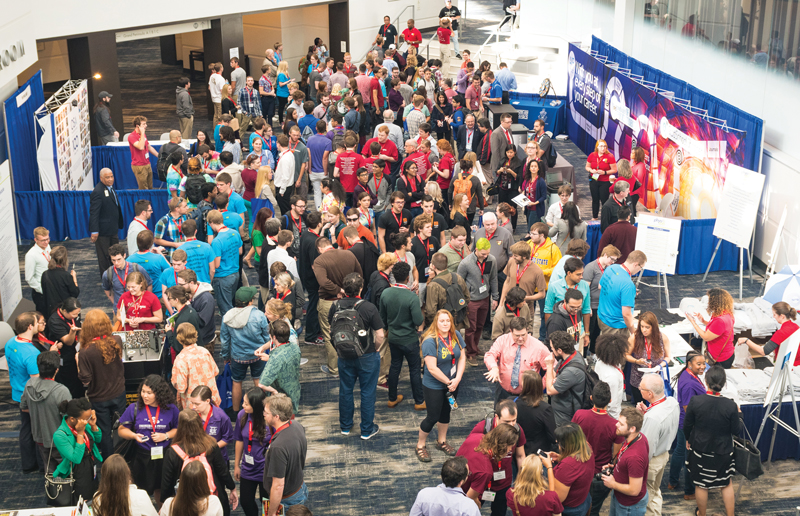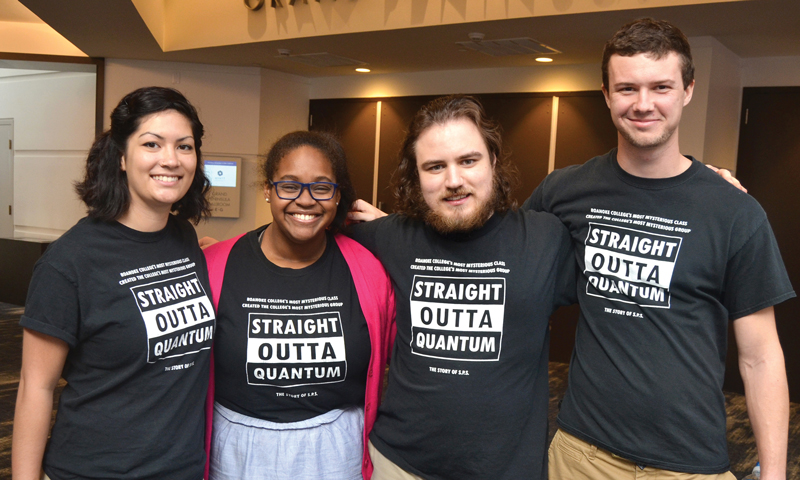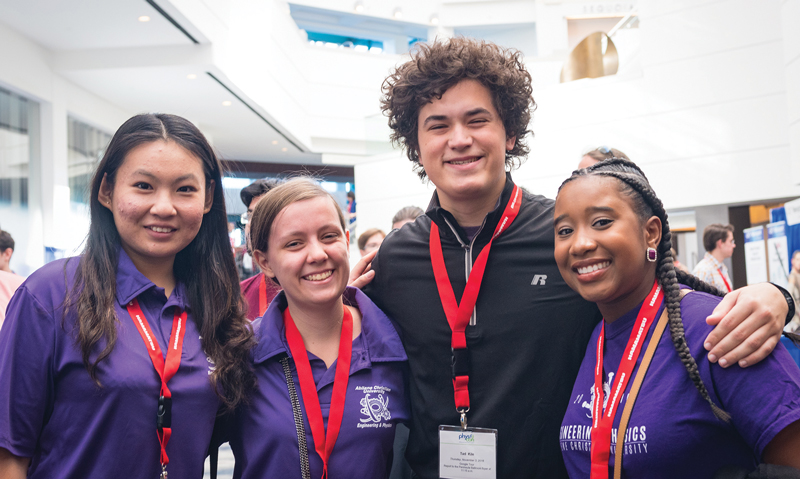Unifying Fields
Spring
2017
Special Feature
PhysCon 2016
Unifying Fields
...at PhysCon 2016
By:Kerry Kidwell-Slak, Assistant Director SPS & Sigma Pi Sigma

Considering that half of the physics degree-granting departments in the US have fewer than 8 students graduate per year,1 many participants at the 2016 Quadrennial Physics Congress were astounded to spend three days surrounded by nearly 1,200 of their fellow physics degree seekers. Unofficially billed as the largest gathering of undergraduate physics students in the world, “PhysCon,” held November 3-5, 2016, in San Francisco, CA, opened students’ eyes to new worlds of study, exciting ways to engage others in physics, and fostered what are sure to be lifelong connections and friendships. In the following pages we’ll provide an overview of the congress and hear from the students about how their lives were transformed through this unique opportunity.

The People
Attendees gravitated to PhysCon from across the country and around the world. Coming from over 180 institutions in 45 states, the District of Columbia, Puerto Rico, Canada, Hungary, and Mexico, and with women making up over 1/3 of the participants, many students were struck by how the congress could be so diverse yet foster the common bonds of a passion for physics and astronomy. Hampton University sophomore Angelina Gallego observed, “It made me feel so welcomed to see such a diverse crowd of men, women, and different ethnicities. It also made me see that there are others just like me out there trying to be physicist[s], too, and it made me feel not so alone."

The Program
The diversity of PhysCon 2016 wasn’t limited to just the faces in the room. Plenaries, workshops, tours, poster sessions, and networking events all provided opportunities to better understand the many facets of physics.
Many students kicked off their congress experience with a tour of one of four Silicon Valley hot spots. The early birds in the crowd left the host Hyatt Regency Hotel at 6:30 a.m. to journey to the SLAC National Accelerator Lab. Students from Cleveland State University describe their visit to SLAC in deeper detail on p. 14.
Other students took advantage of the opportunity to go behind the scenes at X (formerly known as Google X) to learn more about how Project Loon will change how the world views Internet access and just how close we are to having self-driving cars as an everyday occurrence. Two other groups took in a planetarium show at the renowned California Academy of Sciences and traced the roots of smartphones back to the abacus at the Computer History Museum.
When they weren’t exploring our host city, students were encouraged to visit the Exhibit Hall to engage with graduate schools, nonprofit science education and outreach organizations, AIP Member Societies, and other physics-related groups. From finding out the best ways to study for the physics GRE to trying out a bed of nails from California State University – Fresno, students were able to find topics of interest and begin making connections to further their careers. The connections continued via a networking reception where attendees crossed lines of geography and subdiscipline to learn about their companions for the next few days. See p. 16 for reflections on this event from Pacific Union College.
With the energy of these tours, the Exhibit Hall, and the networking reception, students were engaged and enthusiastic about taking part in the opening session. Dr. Willie Rockward, Sigma Pi Sigma president and associate professor at Morehouse College, officially called the congress to order and welcomed the body to San Francisco.
The plenaries were a highlight for many students, as they were able to lay eyes on speakers whom they had previously only read about in textbooks. Dame Jocelyn Bell Burnell opened the congress with an overview of her career and guidance for students on persevering with their work despite obstacles they might encounter. As honorary chair of the congress, Burnell made a point of participating in all aspects of the meeting. Elizabeth Pham, SPS president at Chico State University, remarked, “I got a couple of opportunities to speak to Dame Jocelyn Bell Burnell individually, where we bonded over our experiences as women in a male-dominated field. These conversations, combined with some stories shared during the plenary talks, made me realize that even world-renowned physicists also sometimes bear insecurities and uncertainty about their future and that maybe it is quite all right that I don’t necessarily have it all ‘figured out’ in my early twenties.”
In addition to Burnell, other plenary speakers included Neil Turok of South Africa’s Perimeter Institute; Persis Drell, dean of Stanford’s School of Engineering; S. James Gates of the University of Maryland; and Nobel laureate Eric Cornell. Patrick Brady, an Executive Committee member of the LIGO Scientific Collaboration, closed the congress with a riveting talk on the detection of gravitational waves. Each speaker took care to stress how working on diverse teams has positively impacted their professional trajectories and encouraged the students in the room to find ways to broaden participation in science.
Many students were particularly struck by Brady’s emphasis on this point. SPS reporters from Yale University captured the moment:
Brady charged all students to seek out diverse collaborations throughout the future of our research, stating that diversity improves the team. “This isn’t about us as individuals. This is about us as a group, this is about us as a society,” he said, receiving thunderous applause from the audience. Brady also especially thanked many of the women who worked with him, a point that was not lost on students. “I really like the fact that he personally thanked every single woman on his team,” said Hamna Ali, a physics major concentrating in astronomy at Towson University. “It was good to see that recognized even when his talk was almost entirely scientific. He still hit home on the fact that the community was important to him.”
Friday morning, students awoke to join over 80 scientists from a broad array of fields at Breakfast with the Scientists. Students and professionals were able to take advantage of the intimate format to discuss topics ranging from theories of supersymmetry to career paths for physics majors to advice on how to find a good graduate school.
Some of the conversations inspired students to further action, such as Dava Johnson of Dillard University. “My favorite scientist discussed physics policy and advocacy. As future physicists, there are a number of ways that we can contribute to solving issues that affect both the physics community and the nation as a whole. After the breakfast, some of the students started planning ways to meet with [their] local government. Furthermore, we discussed specific ways to approach our local officials during a meeting. We all plan to pursue research funding for our institutions when we return home.”
The idea of putting the congress into action back home also permeated through the four separate workshop sessions. During the first workshop on Saturday, attendees were encouraged to stretch their creativity and use construction paper to suggest a solution to one of the world’s challenges. On page 15, students from California Polytechnic State University, Pomona and Angelo State University share what they took away from the experience. Later workshop sessions guided students through tips on how to engage and grow their home SPS chapters as well as make their chapters more welcoming for others, and how students can communicate science to the public using examples from superhero comic books. Other students participated in interactive panels to hear “What is Grad School Really Like?” and “Oh the Jobs that Physics Can Lead to…”
The concluding workshop brought all the congress attendees together to brainstorm about the important issues facing the physics community and how we can work together to affect real change. The students from the SPS chapter at Texas Lutheran University reflected, “Collaboration at first with zone-separated, chapter-inclusive tables, then with random tables disregarding zone and chapter, directly showed and verified the theory that diverse modes of thinking as a result of geographical and scientific backgrounds leads to more effective work, in this case with the task of facing the issues that challenge all levels of SPS student chapters.”
For many students the highlight of PhysCon came when they were able to share their own work with others in attendance. Students contributed posters to three sessions and original artwork to a gallery display. The 350+ posters spanned a wide range of topics: modeling gamma-ray burst dynamics, electronic properties of nanoparticles, even guides for conducting outreach in K-12 settings. As Loyola Marymount junior Luciano Manfredi noted, “Although I did not get to talk to everybody, I did speak with a lot of my peers with very diverse projects. Not only were they able to explain them to me and teach me new things, but also, they were incredibly helpful in giving advice for research. Each had something small but unique to contribute to what I should know, just as each was making their small but unique contribution to the whole of physics.”
The art gallery featured the students’ abilities to convey the beauty of science in sculpture, painting, drawing, mixed media, and other formats. Many of the gallery’s visitors were struck by Caroline Bowen’s three-dimensional depiction of the Big Dipper constellation. She took home both the Best in Show and People’s Choice awards. You can read more about Caroline and her artistic vision as well as the other art winners on p. 22.
Thanks to the generosity of the OSA Foundation, top students in both the art gallery and the poster sessions earned awards. Poster winners are listed on pp. 20–21.
The Future
PhysCon would not have been possible without the generosity of a host of sponsors and donors. On pp. 35–38 you will find the names of many of the individuals and organizations who contributed resources to make PhysCon happen and directly support travel costs for more than 200 attendees.
Plans are already in the works for the next PhysCon in 2019, and we hope to involve as many Sigma Pi Sigma alumni as possible. Perhaps you can be one of the scientists at breakfast helping to shape an undergraduate’s career? Or maybe lead a workshop to equip students with valuable professional skills? Or, can you join your peers in contributing financially to make sure PhysCon will persist and more deserving students can attend? Continue to watch this space and consider what role you will play in shaping the future of physics.
1. “Roster of Physics Departments with Enrollment and Degree Data, 2015.” AIP Statistical Research Center, September 2016, read more.


